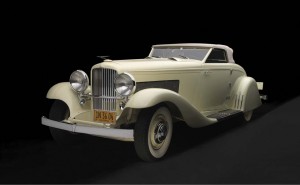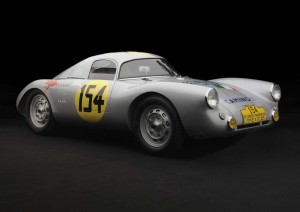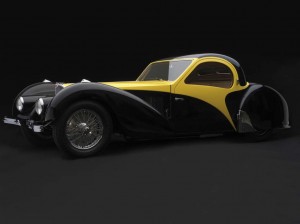By the 1930s, motor vehicles had already proven their utility so the first stylists in Europe and North America began shifting their focus to more expressive design — leaving behind what turned out to be an indelible impression of the automobile as art.
A new exhibit at the High Museum of Art in Atlanta highlights 18 unique vehicles built between 1930 and 1965 that reflect a period often seen as a “golden era,” but which has continued to have an enormous influence on the look of modern automobiles.
“This exhibition will showcase the greatest feats of engineering and luxury design from 1930 to 1965, when cars became synonymous with success, power and wealth,” says High Museum director Michael E. Shapiro. “Created for the privileged few, the luxurious, custom-built automobiles embodied speed, style and elegance, and influenced art, architecture, fashion and design.”
Ken Gross, the former director the Petersen Automotive Museum in Los Angeles and one of the curators of the Atlanta exhibition, adds that each of the cars has its own unique history. One belonged to Clark Gable, another to Steve McQueen and yet another to the Baroness Giesla von Krieger, who was considered one of the 10-most beautiful women in Europe during the 1930s.
The vehicles on display at the High Museum include cars from an array of manufacturers, ranging from half-forgotten brands, such as Delage, to cars built by Mercedes-Benz, Porsche and General Motors.
They include:
- A 1961 Ferrari 250 GT Short wheelbase Berlinetta designed by Pininfarina, with a sharply raked windscreen and a snug body with a low roofline. The alloy body itself came from Scaglietti, and weighed just 200 pounds. It won the GT class, and came in third overall, in the 1961 24 hours of Le Mans.
- A 1961 Aston Martin DB4GT Zagato. Aston and Carozzeria Zagato joined forces to build a quick, agile and winning GT. Zagato used a super-light construction technique, a thin skin of aluminum stretched over a cage of small-diameter steel tubing.
-

Modern makers might have learned a critical lesson from the 1935 Duesenberg JN Roadster: don't bring out your most expensive products during an economic crisis.
A 1959 Chevrolet Corvette Sting Ray. Bill Mitchell, GM’s famous design chief, paid for its development because the car was designed as a racing machine after GM had officially decided to drop out of motor sports. The prototype’s futuristic styling, however, was used for the fabled 1963 Corvette Stingray.
- A 1953 Porsche 550 LeMans coupe. A triple-threat, it was a commercial, track and artistic success. It was Porsche’s first racing car andfounder Ferry Porsche concluded that without large advertising budgets, racing was the best way for the struggling company to make its mark and bolster its fortunes.
- A 1948 Tucker Model 48 Torpedo . Capturing the big, bold spirit of post-War America, Preston Tucker’s offering featured a “rocket-style” exterior design, bold grill and a rear-mounted engine that was designed so it could be removed for easy service. Tucker barely built 50 before his dream came crashing to a halt.
- A 1938/39 Porsche Type 64 Coupe. The only prewar Porsche was built for a Berlin to Rome road race cancelled after the outbreak of World War II. Only one of the three pre-war Porsche’s survived but the German automaker hand-built an exact replica from original plans for its new museum in Stuttgart, Germany.
Other rare but influential models on display at Atlanta’s High Museum include a 1938 Alfa Romeo 8C200B Touring Berlinetta, considered one of the most technically advanced sports cars of its day, a 1935 Duesnberg JN Roadster – which unfortunately debuted in the depths of the Great Depression – and a 1933 Pierce-Arrow Silver Arrow, a showpiece displayed at the Chicago Century of Progress International Exposition in 1933.
The auto industry ultimately shifted away from the sort of opulent over-the-top designs and one-of-a-kind hand-built models highlighted in the High Museum exception. Efforts to revive the carrossier approach have largely failed, in large part due to restrictive safety regulations that make it difficult to justify the costs. Nonetheless, organizers of the event argue that the vehicles on display had a significant impact on modern automotive design and engineering.
“The Allure of the Automobile” opened on March 21 and the exhibition continues through June 20, 2010.


